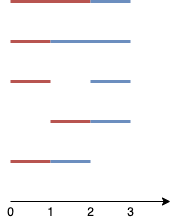- {x}
- Find the Missing IDs
- Maximum Nesting Depth of the Parentheses
- Maximal Network Rank
- Split Two Strings to Make Palindrome
- Count Subtrees With Max Distance Between Cities
- Maximum Font to Fit a Sentence in a Screen
- Mean of Array After Removing Some Elements
- Coordinate With Maximum Network Quality
- Number of Sets of K Non-Overlapping Line Segments
- Fancy Sequence
- All Valid Triplets That Can Represent a Country
- Largest Substring Between Two Equal Characters
- Lexicographically Smallest String After Applying Operations
- Best Team With No Conflicts
- Graph Connectivity With Threshold
- Design an Expression Tree With Evaluate Function
- Slowest Key
- Read More...

Number of Sets of K Non-Overlapping Line Segments
Given n points on a 1-D plane, where the ith point (from 0 to n-1) is at x = i, find the number of ways we can draw exactly k non-overlapping line segments such that each segment covers two or more points. The endpoints of each segment must have integral coordinates. The k line segments do not have to cover all n points, and they are allowed to share endpoints.
Return the number of ways we can draw k non-overlapping line segments. Since this number can be huge, return it modulo 109 + 7.
Example 1:

Input: n = 4, k = 2
Output: 5
Explanation: The two line segments are shown in red and blue.
The image above shows the 5 different ways {(0,2),(2,3)}, {(0,1),(1,3)}, {(0,1),(2,3)}, {(1,2),(2,3)}, {(0,1),(1,2)}.
Example 2:
Input: n = 3, k = 1
Output: 3
Explanation: The 3 ways are {(0,1)}, {(0,2)}, {(1,2)}.
Example 3:
Input: n = 30, k = 7 Output: 796297179 Explanation: The total number of possible ways to draw 7 line segments is 3796297200. Taking this number modulo 109 + 7 gives us 796297179.
Constraints:
2 <= n <= 10001 <= k <= n-1
Solution Explanation
This problem asks to find the number of ways to draw exactly k non-overlapping line segments on n points arranged on a 1D plane. The key to solving this efficiently is using dynamic programming.
Approach:
We define two DP tables:
f[i][j]: The number of ways to drawjline segments using the firstipoints, where the last segment doesn't end at pointi.g[i][j]: The number of ways to drawjline segments using the firstipoints, where the last segment ends at pointi.
The recurrence relations are:
-
f[i][j] = f[i-1][j] + g[i-1][j]: We can either extend the current set of segments to i-1 (f[i-1][j]) or add a segment which doesn't end at i (g[i-1][j]) -
g[i][j] = g[i-1][j] + f[i-1][j-1] + g[i-1][j-1]:To end a segment at i, we can extend the segments already ending at i-1 (g[i-1][j]), or add a new segment ending at i with a segment ending at i-1 (f[i-1][j-1] or g[i-1][j-1]).
The base case is f[1][0] = 1 (no segments can be formed with one point). The final answer is (f[n][k] + g[n][k]) % mod, where mod = 10^9 + 7 to handle large numbers.
Time Complexity Analysis:
The DP tables have dimensions (n+1) x (k+1). We iterate through these tables once to fill them. Therefore, the time complexity is O(n*k).
Space Complexity Analysis:
We use two DP tables of size (n+1) x (k+1). Therefore, the space complexity is O(n*k).
Code Explanation (Python):
class Solution:
def numberOfSets(self, n: int, k: int) -> int:
mod = 10**9 + 7
f = [[0] * (k + 1) for _ in range(n + 1)]
g = [[0] * (k + 1) for _ in range(n + 1)]
f[1][0] = 1
for i in range(2, n + 1):
for j in range(k + 1):
f[i][j] = (f[i - 1][j] + g[i - 1][j]) % mod
g[i][j] = g[i - 1][j]
if j:
g[i][j] += f[i - 1][j - 1]
g[i][j] %= mod
g[i][j] += g[i - 1][j - 1]
g[i][j] %= mod
return (f[-1][-1] + g[-1][-1]) % mod
The code directly implements the recurrence relations described above. The modulo operator (%) is used throughout to prevent integer overflow. The final result is the sum of the last entries in both DP tables, taken modulo 10^9 + 7. The other languages (Java, C++, Go, TypeScript) follow the same logic with only syntax differences.